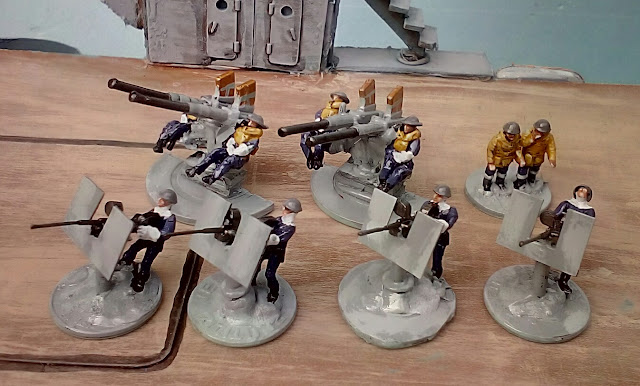When I was a teenager I got somehow a Scenic Effects catalogue. Opening it made me dream about Monte Cassino, Tarawa and also a big 20mm USN Aircraft Carrier. No credit card, no nothing, and ordering expensive stuff from the USA made me put aside that possibility. Years later I made my own Tarawa table but always thought about building an Aircraft Carrier. Or maybe two.
With RF2 rules book I got another nice vision of a scratchbuilt British Aircraft Carrier with several pictures devoted to it.
In fact for the 20mm wargames size I think that no more than the smaller Escort Carriers can be built, otherwise you will need to leave your house if wanting to build a true big one in the line of the USN Entreprise or HMS Illustrious class.
But what really made me build this one was this Luppa Fairey Swordfish that came out two weeks ago. Its the only 1/72nd scale aircraft from the collection with fixed landing gear and so apt for the deck of an Aircraft Carrier. Quickly I added some crew and started my carrier project.
Looking for more aircraft in the stash this Altaya Blackburn Skua was found and its another useful aircraft for a British Carrier at least up to 1942.
The model was built in wood, Blue Board and heavy duty 3mm card. The bridge was made roughly of pieces of Blue Board and its not a true Attacker Class bridge but more of a generical one in order to be used with other classes of Escort Carriers.
Only a fraction of the AA fire power of these Carriers was placed in the model. These 20mm Oerlikons at the stern were scratchbuilt but more on that later.
The other side of the bridge with some Airfix figures, a spotlight and some surplus doors taken from a converted Matchbox Corvette and made into a British destroyer a few years ago.
Both sides of the ship have these double 40mm guns made from Atlantic parts and converted figures from the HAT WW1 US artillery set. The bays were the guns sit are made from spray covers.
Details of the bow with anchor and more Oerlikon. The figures are Atlantic Conversions.
The Hat and Atlantic converted Royal Navy figures and the Airfix ones.
The bases are mostly Euro coins (well, plastic ones from the supermarkets). The Atlantic figures got new arms made of two component paste, the stucture and shield are Evergreen plastic card and tubing and the guns themselves were taken from the stash of Airfix LVT-4.
And now a bit of magic...
Voilá! The Royal Navy flag can be replaced by another from the USN. There is a small transparent break in the middle of the pole (it should be just a thin rope, but it get sturdier like this) and the flags are glued to a piece of transparent protective brush tubing. The hand you can see is of your truly yours and was made 53 years ago by mom and dad.
With USN flag...
... becomes a USN Bogue class Escort Aircraft Carrier. In fact I chose this class as the Bogue is the original one and made from transformed cargo ships. Some were sent to the RN and became the Attacker class.
I´m finished with USN Oerlikons and so I used what I had around which were these 50. cal HMG´s from Britannia.
Also new double 40mm guns were made due to different uniforms. These were made from Hat WW1 bodies and Britannia metal heads.
The lifeboats are German Revell.
This conversion was also made easy because I already had a few USN aircraft from Altaya with lowered landing gear. Left to right, a SBD Dauntless, Grumman F6F Hellcat and Grumman TBF Avenger. I also have all of these in flight mode and ready for action.
The Britannia USN crew.
The boat is 80cm X 20cm and it will rest on top of a cabin as there is no more place for it inside any of them...
Now some construction clues. First, the bow shape was made from 3mm heavy duty card.
The general shape was achieved with three internal divisions glued inside the boat and the whole piece was put together with the help of a hot glue gun.
The main deck is made out of the wood I use for my vehicles and figure bases. Its a type of plywood covered in one of the sides with a white acrylic layer giving it extra strenght.
The general appearence before priming with two squares of card to simulate the elevators that lead to the main hangar deck.
The bridge looked better after carving than it looks now after painting. I covered it with PVA glue before appying acrylic spray but some got through and made a mess out of it.
The sea level and waves was made with the glue gun .
Thinking I was making the right decision I plastered the bridge and contributed even more to the scary look you can see in the finished model. Unfortunately I only noticed after painting.
The stern spotlights were made from PSC A9 surplus tank parts and the AA bays were taken secretly from my 3 YO toy boxes with the firm but useless opposition of my wife and the complete ignorance of the victim!
All this was made only from stuff I had laying around as confinement and the subsequent laziness didn´t let me go to any DIY store.
This model is usable by the British and US both in the Mediterranean and Pacific is support of land operations even if my wargaming can be called ... erratic, at least, one in each 10 years being my average.
In the future I also want to make another Escort Carrier this time a Japanese one. These have some fascinating camouflages and will be another more than probable joy to build.
Next: More French 1940.

























































